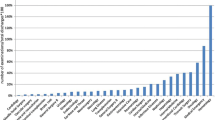Abstract
Background
There has been a year on year increase in imaging requests at our academic institution. The iRefer guidelines are produced by the Royal College of Radiologists in the UK and are designed to prevent inappropriate imaging and radiation exposure. They have been available to general practitioners and hospital physicians in Ireland since March 2015.
Aims
Our aims were to determine the proportion of inappropriate imaging referrals pre- and post-guideline introduction and to calculate the cost and dose estimates for inappropriate scans.
Methods
A retrospective review of 1124 radiographs was performed with reference to a validated audit template. Emergency department, in-patient, and general practitioner referrals were reviewed. Cost and cumulative dose estimates were calculated for inappropriate referrals taking into account salaries, average time spent performing/reporting radiographs, and median effective dose values.
Results
The introduction of the iRefer guidelines has not significantly affected the proportion of inappropriate radiograph referrals at our institution, 42% pre-introduction and 43% post-introduction. We identified 784 inappropriate referrals across 6 radiograph subtypes, imparting a total median effective dose of 65.1 mSv to patients. The time spent performing inappropriate abdominal and spinal radiographs in 2017 yielded an estimated cost of €8036.40.
Conclusion
A significant amount of inappropriate radiographs continue to be requested and performed, exposing patients to needless ionizing radiation and wasting staff members time at a financial cost. Interventions are needed to decrease inappropriate referrals.
Similar content being viewed by others

Abbreviations
- ESR:
-
European Society of Radiology
- RCR:
-
Royal College of Radiologists
- UK:
-
United Kingdom
- HSE:
-
Health Service Executive
- GP:
-
General practitioner
- PNS:
-
Para-nasal sinus
- NB:
-
Nasal bone
- AR:
-
Abdominal radiographs
- ED:
-
Emergency department
- IP:
-
In-patient
- SR:
-
Spinal radiograph
- CDS:
-
Clinical decision support
- mSv:
-
Millisieverts
References
Hendee WR, Becker GJ, Borgstede JP, Bosma J, Casarella WJ, Erickson BA, Maynard CD, Thrall JH, Wallner PE (2010) Addressing overutilization in medical imaging. Radiology 257:240–245. https://doi.org/10.1148/radiol.10100063
Smith-Bindman R, Miglioretti DL, Larson EB (2008) Rising use of diagnostic medical imaging in a large integrated health system. Health Aff (Millwood) 27:1491–1502. https://doi.org/10.1377/hlthaff.27.6.1491
Knechtges PM, Carlos RC (2007) The evolving role of radiologists within the health care system. J Am Coll Radiol 4:626–635. https://doi.org/10.1016/j.jacr.2007.05.014
HSE (2006) Health service executive code of governance: framework for the corporate and financial governance of the health service executive. https://https://www.hse.ie/eng/services/publications/corporate/codeofgovernance.pdf. Accessed 01 Dec 2018.
Frenz MB, Mee AS (2005) Diagnostic radiation exposure and cancer risk. Gut 54:889–890. https://doi.org/10.1136/gut.2005.066605
Lin EC (2010) Radiation risk from medical imaging. Mayo Clin Proc 85:1142–1146; quiz 1146. https://doi.org/10.4065/mcp.2010.0260
European Society of Radiology (ESR) ES of R (2011) White paper on radiation protection by the European Society of Radiology. Insights Imaging 2:357–362. https://doi.org/10.1007/s13244-011-0108-1
NHS (2014) Diagnostic imaging dataset annual statistical release 2013/14. https://www.england.nhs.uk/statistics/statistical-work-areas/diagnostic-imaging-dataset/diagnostic-imaging-datasetdiagnostic-imaging-dataset-2013-14-data/. Accessed 01 Dec 2018
Culleton S, Torreggiani W (2014) Analysis of the last decade of weekend out-of-hours CT imaging: how have things changed? Ir Med J 107:77–79
Broder JS, Bhat R, Boyd JP, Ogloblin IA, Limkakeng A, Hocker MB, Drake WG, Miller T, Harringa JB, Repplinger MD (2016) Who explicitly requests the ordering of computed tomography for emergency department patients? A multicenter prospective study. Emerg Radiol 23:221–227. https://doi.org/10.1007/s10140-016-1382-5
Fine B, Dhanoa D (2014) Imaging appropriateness criteria: why Canadian family physicians should care. Can Fam Physician 60:217–218
iRefer |. https://www.irefer.org.uk/. Accessed 19 Nov 2017
Audit of compliance with imaging referral guidelines | The Royal College of Radiologists. https://www.rcr.ac.uk/audit/audit-compliance-imaging-referral-guidelines. Accessed 20 Dec 2017
Patient Safety - Radiation Dose in X-Ray and CT Exams. https://www.radiologyinfo.org/en/info.cfm?pg=safety-xray. Accessed 17 Nov 2018
Remedios D, Drinkwater K, Warwick R, Clinical Radiology Audit Committee (CRAC), The Royal College of Radiologists, London (2014) National audit of appropriate imaging. Clin Radiol 69:1039–1044. https://doi.org/10.1016/j.crad.2014.05.109
Vartanians VM, Sistrom CL, Weilburg JB, Rosenthal DI, Thrall JH (2010) Increasing the appropriateness of outpatient imaging: effects of a barrier to ordering low-yield examinations. Radiology 255:842–849. https://doi.org/10.1148/radiol.10091228
Sim EY, Tan DJA, Abdullah HR (2017) The use of computerized physician order entry with clinical decision support reduces practice variance in ordering preoperative investigations: a retrospective cohort study. Int J Med Inform 108:29–35. https://doi.org/10.1016/j.ijmedinf.2017.09.015
Holland K, McGeoch G, Gullery C (2017) A multifaceted intervention to improve primary care radiology referral quality and value in Canterbury. N Z Med J 130:55–64
Author information
Authors and Affiliations
Corresponding author
Ethics declarations
Conflict of interest
The authors declare that they have no conflict of interest.
Ethical approval
This article does not contain any studies with human or animal participants performed by any of the authors.
Additional information
Publisher’s note
Springer Nature remains neutral with regard to jurisdictional claims in published maps and institutional affiliations.
Appendix
Appendix
Rights and permissions
About this article
Cite this article
Ryan, J.W., Hollywood, A., Stirling, A. et al. Evidenced-based radiology? A single-institution review of imaging referral appropriateness including monetary and dose estimates for inappropriate scans. Ir J Med Sci 188, 1385–1389 (2019). https://doi.org/10.1007/s11845-019-02005-8
Received:
Accepted:
Published:
Issue Date:
DOI: https://doi.org/10.1007/s11845-019-02005-8



